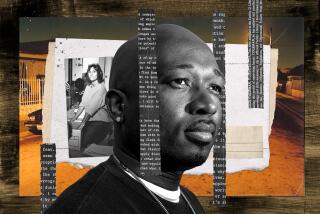Kraft Judge Points to Evidence, Denies Motion for Acquittal
Saying he has “never seen a case with such overwhelming circumstantial evidence,” the judge in the Randy Steven Kraft trial on Tuesday denied a defense request that he acquit Kraft on 14 of 16 murder counts.
Superior Court Judge Donald A. McCartin acknowledged that in eight of the murders, prosecutors have to rely on similarities among those cases and with the other murders where some physical evidence exists. But the judge added that “clearly there are certain threads that run through the evidence.”
Some, the judge said, “just jump out at you.”
Kraft, 43, is charged with 16 murders in what some experts say is the most expensive and potentially the longest trial in Orange County history. Prosecutors have rested their case, and the jury is scheduled to return to McCartin’s Santa Ana courtroom Jan. 9 for the start of the defense’s case.
The Kraft attorneys Tuesday made a dramatic and sometimes passionate plea to the judge to acquit Kraft in 14 murders, particularly eight murders that they insisted lack any prosecution evidence.
Kraft attorney C. Thomas McDonald argued that Deputy Dist. Atty. Bryan F. Brown took only 45 minutes to present his entire case in the murder of 20-year-old Ronnie G. Wiebe--”20 minutes of which was futzing around with the overhead projector.”
If prosecutor Brown thinks Kraft killed Wiebe, “by God make him prove it,” McDonald said. “It’s not there.”
McDonald and defense attorney William J. Kopeny forcefully argued that although there may be a hundred “trivial” similarities in the series of murders, there also are major dissimilarities.
McDonald argued that the evidence in the Wiebe murder “is zero, absolute zero. . . . There is not a single common thread that is so distinctive that it says Mr. Kraft did this.”
The attorneys challenged Brown to articulate for the court the evidence that he sees in each murder. Brown declined. After a lengthy argument by Kopeny, Brown summed up his case in less than a minute: “It’s a seamless web of guilt that is shrouding down on Mr. Kraft. The evidence is overwhelming.”
The judge responded that the prosecutor should state for the record his arguments on the counts challenged by the defense--and then continued to make those arguments himself. Brown finally jumped back into the fray after the defense began attacking the judge’s arguments.
For example, the judge disagreed with the defense contention that the evidence in the Wiebe murder is insufficient.
Wiebe’s body was found along the eastbound 7th Street on-ramp to the San Diego Freeway in Seal Beach on July 30, 1973. His body had been clothed after death, and one of his socks was found in a body cavity. His shoes and belt were missing. He died of strangulation by a cord or rope, according to the pathologist.
Although the defense claims that none of those facts link the crime to Kraft, the judge pointed to them as important evidence because of their similarity to conditions in other murders in the case. The judge noted that another victim, Edward Daniel Moore, was found with a sock in a body cavity 7 months earlier, and his body had been dumped just a short distance from where Wiebe was dumped.
The defense countered that there was no evidence tying Kraft to Moore either.
But the judge and prosecutor Brown both cited the list found in Kraft’s car when he was arrested. Prosecutors consider the 61-entry list to be Kraft’s score card of his victims. Brown claims that “7th Street” on the list refers to Wiebe, and “EDM” on the list refers to Moore.
“The conclusion that (the EDM entry) is a statement--’I have killed Edward Daniel Moore’--is absolutely inescapable,” Brown said.
Defense attorney Kopeny countered that prosecutors have failed to prove Moore’s killer knew his middle initial. The defense has called the list meaningless.
Kopeny also vigorously challenged the evidence related to the murder of Mark Howard Hall, who was found near Bedford Peak in south Orange County. Prosecutors presented evidence that Kraft’s fingerprints were found on a piece of glass from a shattered bottle near the body.
“They’ve got this lone thumbprint of unknown vintage,” Kopeny said. He argued that prosecutors failed to prove when the fingerprint was left there.
Brown told the judge: “This business about the glass and Mark Hall is about all I can take.” He noted that the bottle’s neck had blood on it and that the object was found just 11 inches from the victim’s head.
That’s not good enough, Kopeny challenged. Who knows whether Kraft left his prints there earlier, before the real killer used the bottle while killing Hall.
Kopeny also told the judge that although his strongest arguments apply to the eight murders in which prosecutors relied on the killer’s method of operation, he is not conceding a strong case against Kraft in the other murders.
In the Wyatt Loggins and Rodger James DeVaul Jr. murders, for example, the victims’ pictures were found in Kraft’s car.
“The prosecutor must prove that Mr. Kraft killed them, not just that he had some connection with them,” Kopeny argued.
The judge said he would permit the defense to renew its arguments at the conclusion of defense evidence.
More to Read
Sign up for Essential California
The most important California stories and recommendations in your inbox every morning.
You may occasionally receive promotional content from the Los Angeles Times.









